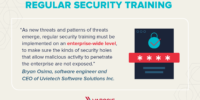In an era where cybersecurity threats are increasingly sophisticated, the traditional approach of trusting everything within a network is no longer sufficient. Enter the Zero Trust Security model—a paradigm shift in cybersecurity strategy. In this article, we’ll explore what Zero Trust Security is and provide quick tips for adopting this robust security model.
Understanding Zero Trust Security
Zero Trust Security operates on the principle of “never trust, always verify.” Unlike traditional security models that assume trust within the network, Zero Trust assumes zero trust from the start. Every user, device, and application, whether inside or outside the network, is treated as potentially untrusted.
Quick Tips for Implementing Zero Trust Security
1. Identify and Classify Assets ️
Begin by conducting a thorough inventory of your organization’s digital assets. Classify assets based on sensitivity and importance. Understanding what needs protection is fundamental to implementing a Zero Trust model effectively.
2. Implement Least Privilege Access
Adopt the principle of least privilege, ensuring that users and systems have the minimum level of access necessary to perform their roles. This limits the potential damage that can result from a compromised account or system.
3. Micro-Segmentation for Network Isolation
Leverage micro-segmentation to divide your network into isolated segments. This limits lateral movement for attackers, as even if one segment is breached, the rest of the network remains protected.
4. Continuous Monitoring and Analytics
Implement continuous monitoring and analytics to detect anomalous behavior. This involves real-time analysis of network traffic, user activity, and system behavior to identify potential security threats promptly.
5. Multi-Factor Authentication (MFA) ️
Require multi-factor authentication for all user accounts. MFA adds an extra layer of security by verifying users’ identities through multiple methods, such as passwords, biometrics, or security tokens.
6. Secure Access from Anywhere
As remote work becomes more prevalent, ensure that secure access is maintained regardless of the user’s location. Zero Trust extends beyond the traditional network perimeter to secure access from anywhere in the world.
7. Encrypt Data in Transit and at Rest
Utilize encryption to protect data both in transit and at rest. This safeguards sensitive information from interception or unauthorized access. Encryption is a fundamental component of a Zero Trust Security architecture.
8. Regularly Update and Patch Systems
Keep systems and software up to date with the latest security patches. Regular updates close known vulnerabilities and reduce the risk of exploitation by cyber threats.
9. Educate and Train Personnel
Security awareness and training are crucial components of Zero Trust. Educate employees on cybersecurity best practices, social engineering tactics, and the importance of adhering to security policies.
10. Incident Response Planning and Drills
Develop a comprehensive incident response plan to address security incidents promptly. Regularly conduct drills to ensure that your team is well-prepared to respond to potential security breaches.
Conclusion: Elevating Your Cybersecurity Posture ️
Zero Trust Security is not just a model; it’s a mindset that aligns with the evolving nature of cyber threats. By adopting the principles of least privilege, micro-segmentation, and continuous monitoring, organizations can enhance their cybersecurity posture and protect against both internal and external threats. Implementing a Zero Trust model requires a holistic approach, combining technology, policies, and user education to create a robust defense against the ever-changing cybersecurity landscape.








